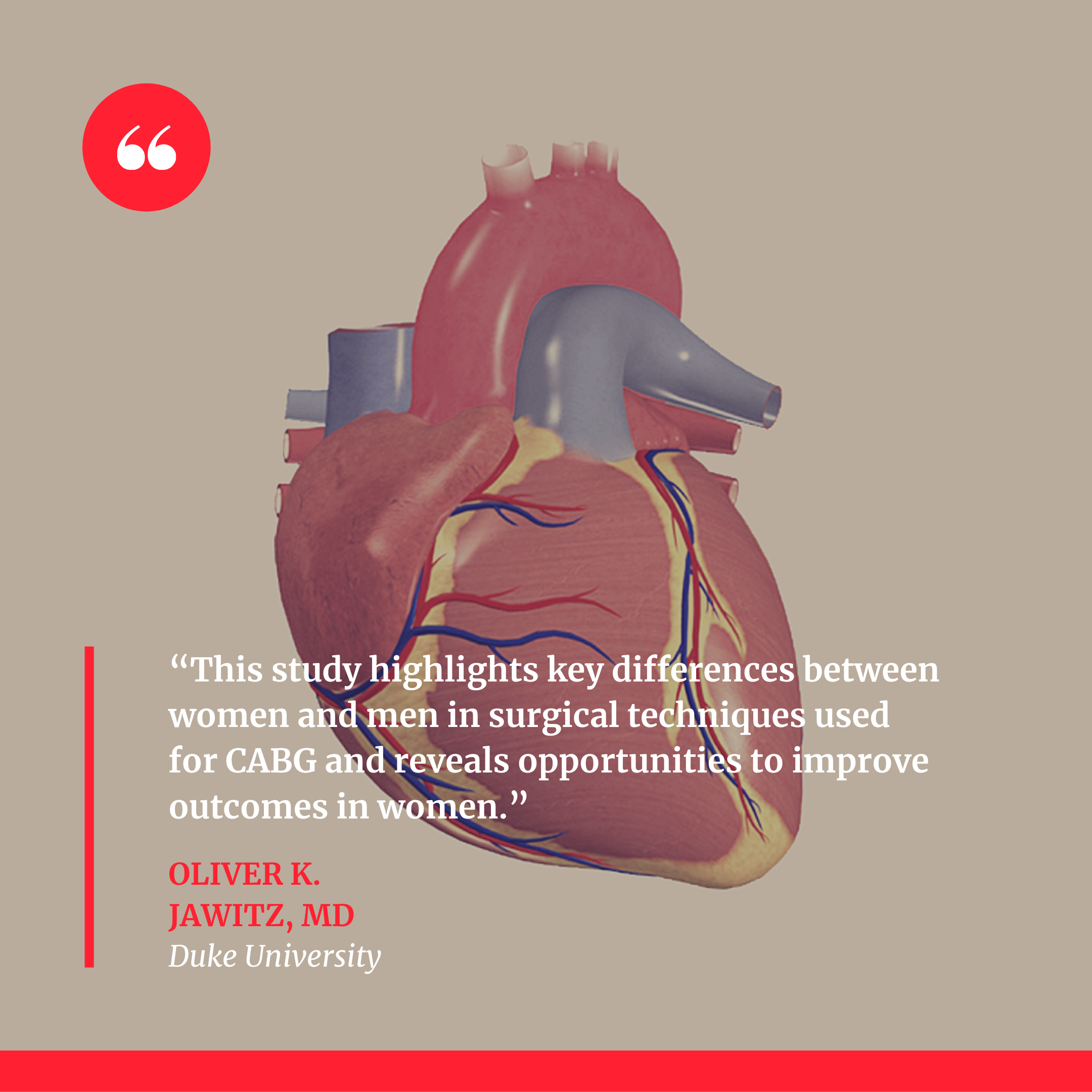“This study highlights key differences between women and men in surgical techniques used for CABG and reveals opportunities to improve outcomes in women,” said Oliver K. Jawitz, MD, from Duke University in Durham, North Carolina.
Using the STS Adult Cardiac Surgery Database—which contains records of nearly all CABG procedures performed in the US—Dr. Jawitz and colleagues from Duke and The Johns Hopkins University School of Medicine in Baltimore, Maryland, identified adult patients who underwent first-time isolated CABG from 2011 to 2019. Researchers analyzed detailed demographic, clinical, and procedural data from more than 1.2 million patients.
The correlation between female sex and three different CABG surgical techniques that are recommended in official US and European guidelines was examined closely. According to Dr. Jawitz, all of these surgical approaches—grafting of the left internal mammary artery (LIMA) to the left anterior descending (LAD) artery, complete revascularization, and multiarterial grafting—have been associated with improved short and/or long-term outcomes. However, the results showed that women were 14%-22% less likely than men to undergo CABG procedures with these revascularization strategies.
“With these findings, we did in fact see less aggressive treatment strategies with women,” said Dr. Jawitz. “It is clear that sex disparities exist in all aspects of care for patients with coronary artery disease (CAD), including diagnosis, referral for treatment, and now, in surgical approaches to CABG. We must ensure that female patients undergoing CABG are receiving evidence-based, guideline-concordant techniques.”
A cardiac surgeon who was not affiliated with the study said that the sheer volume of patient records analyzed is meaningful. “This was an important study, especially since it utilized the world’s largest cardiac surgical database to document a difference in surgical strategies between men and women who underwent coronary bypass surgery, said Robbin G. Cohen, MD, MMM, from Keck School of Medicine of the University of Southern California in Los Angeles. “Now we need to understand the reasons for this disparity and the implications for both short- and long-term results.”
While multifactorial, the undertreatment of CAD in women largely stems from a failure to recognize key differences in cardiovascular risk factors and symptoms in females compared with males, explained Dr. Jawitz.
Women are much more likely to experience atypical, subtler symptoms of heart disease such as fatigue, abdominal pain, nausea, vomiting, indigestion, and back pain. Sometimes, women do not even feel the obvious chest pain and pressure that are characteristic of CAD. As far as risk factors, women have their own unique set, including relatively high testosterone levels prior to menopause, increased hypertension during menopause, and higher levels of stress and depression.
Another challenge has been that women’s health historically has been focused largely on mother and child issues, as well as early diagnosis and treatment of breast cancer. These conversations need to include a stronger emphasis on cardiovascular risk factors and interventions, which is vital to successfully tackling the leading cause of death for women in the US—heart disease, according to Dr. Jawitz.
In addition, women tend to have a longer time from symptom onset to diagnosis and from diagnosis to medical intervention. Each of these delays allows the disease to worsen over time, increasing the risk for poor surgical outcomes. And when women finally are referred for bypass surgery, they continue to be disadvantaged, since they often do not receive CABG with LIMA to LAD, complete revascularization, or multiarterial grafting—all of which are associated with improved outcomes.
“Delayed diagnosis of CAD in women leads to late initiation of key behavioral and pharmacologic interventions for minimizing heart disease risk, as well as delayed referral for invasive diagnostic and therapeutic procedures, including surgical revascularization with CABG,” said Dr. Jawitz. “This often means that by the time female patients undergo these procedures, they have more severe disease than males, as well as a greater number of comorbidities, which leads to worse outcomes.”
In some clinical trials, women remain grossly underrepresented. According to an unrelated analysis of research data, less than 40% of all people enrolled in cardiovascular clinical trials from 2010 to 2017 were women. Lack of knowledge often is cited as a reason for these persistent disparities.
“The evidence available for various therapies and interventions is disproportionally based on male cardiovascular biology,” said Dr. Jawitz. “But as research in this area becomes more robust, data will continue to emerge showing that cardiovascular disease manifests differently by sex. Raising awareness will go a long way toward minimizing sex differences in CAD outcomes.”
Moving forward, guidelines must be developed that reflect the important differences between men and women in CAD manifestation, which certainly will require increased representation of female patients in clinical trials of cardiovascular therapies, explained Dr. Jawitz.
“Now that we have identified specific differences in surgical approaches to CABG between females and males, we must further elucidate how these differences result in disparate outcomes such as increased mortality, readmissions, and complications,” he said. “These findings will help inform the development of sex-specific guidelines for the diagnosis and management of cardiovascular disease.”
###
For more information, contact STS Senior Media Relations Manager Jennifer Bagley at 312-202-5865 or [email protected].
Founded in 1964, The Society of Thoracic Surgeons is a not-for-profit organization representing more than 7,500 cardiothoracic surgeons, researchers, and allied health care professionals worldwide who are dedicated to ensuring the best possible outcomes for surgeries of the heart, lung, and esophagus, as well as other surgical procedures within the chest. The Society’s mission is to advance cardiothoracic surgeons’ delivery of the highest quality patient care through collaboration, education, research, and advocacy.


